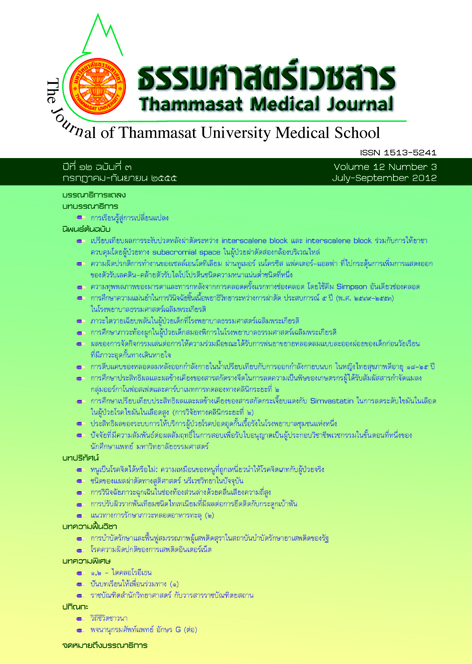Constipation in cerebral palsy patients at Thammasat University Hospital
Keywords:
ท้องผูก, โรคสมองพิการ, โรคอุจจาระเล็ด, Constipation, Cerebral Palsy, EncopresisAbstract
Introduction: Cerebral palsy patient usually has constipation problem which is the effect from the reduction of muscular tone of the bowel and inability of intentional movement control, including having inadequate effort to pass feces. It affects a child to have a stomachache, anorexia, vomit, fl atulence, encopresis, and anal fi ssure. Then, it leads to failure to thrive or malnutrition, and creates the risk of urinary tract infection. Therefore, the researcher would like to study about the clinical manifestation and treatment method of constipation in cerebral palsy patient in Thailand.We would start from group of cerebral palsy patient in Thammasat university hospital in order to lead for the diagnosis and treatment in the future.
Objective: To explore the frequency of constipation and study its clinical manifestation in cerebral palsy patient who came to have a treatment at Thammasat university hospital.
Method: We chose the prospective cross-sectional study research. The data collection was done by interviewing with the caregiver together with body inspection of cerebral palsy patients who had age under 15 years participated in a treatment at Thammasat university hospital, during 1st April 2009 to 31st July 2010.We used the data record about constipation history, physical examination, together with history about special investigation of gastrointestinal system and neurological system.
Results: The participated 24 persons of cerebral palsy patient were 54.2% female and 45.8% male. For the type of cerebral palsy, 70.8% was spastic quadriplegia, 25% was spastic diplegia, and 4.2% was spastic hemilplegia. The average age was 47.8 months (SD = 35.9) and the average income was 4,587 Baht per person (SD = 2,601). For the food receiving, the patients ate by themselves 75% and received by gastrostomy tube 25%. From this study, we found the intensity of constipation in 15 persons or 62.5%.Cerebral palsy patients who had constipation condition, had cramping abdominal pain 20%, abdominal distention 13.3%, reduction of eating ability 20%, and did not have anything abnormal 46.7%. From gathering complication in this group of patients, there were the patients who had anal fi ssure 33.3%,rectal bleeding 13.3%, and the patients had urinary tract infection 6.7%. There was the medicine using in constipation treatment in 13 patients or 86.6%, used laxative 33.3%, used saline-containing balloon enema 20%, and glycerine rectal suppository 33.3%. For the part of behavior modifi cation, 60% of cerebral palsy patient who had constipation was modifi ed by food modifi cation. For the increasing in body movement and sitting on cuspidor after meal methods were popular as the second and third rank, or 26.7% and 6.7% respectively. No patient that did not get any treatment.
Conclusion: It has already been known that one factor which affects cerebral palsy patients tend to have constipation more than normal children is the abnormal muscle tone. That is why they could not move their bodies like the normal children. Therefore, apart from treatment this group of patients with food modification, sitting on cuspidor after the meal, or medicine, the important thing we have to mention is the posture adaptation to be close to normal children and suitable for their body effi ciency. Altogether,we should refer with the long term study in order to gather the enough amount of patient to be compared in each kind of cerebral palsy. Furthermore, we will be able to receive the information of continuous treatment result for using in factor-on-treatment analysis, which may lead to pattern development of constipation treatment in cerebral palsy patients later on.
Key words: Constipation, Cerebral Palsy, Encopresis


